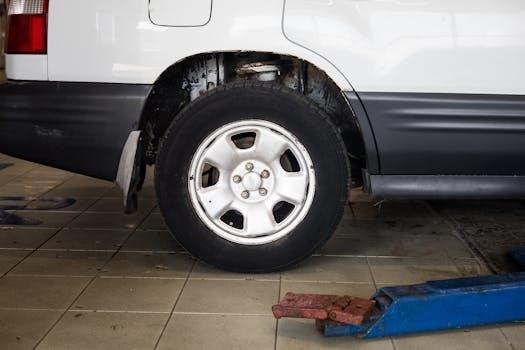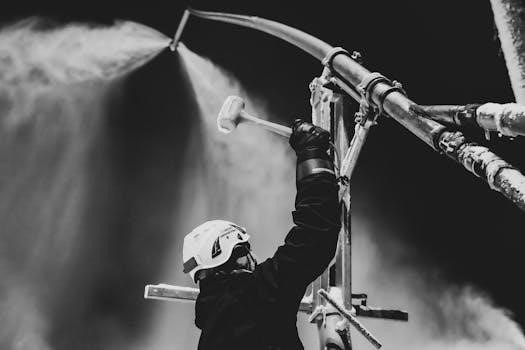how to manually retract hydraulic jacks
Understanding Hydraulic Jack Systems
Hydraulic jack systems are commonly found in RVs for leveling and stabilization. They use hydraulic fluid and pressure to extend and retract the jacks. These systems often have an electric pump and solenoid valves to control the fluid flow. Understanding the basic components will help you troubleshoot retraction issues.
Types of Hydraulic Jack Systems
There are primarily two types of hydraulic jack systems⁚ spring-retract (single-acting) and power-retract (double-acting). Spring-retract jacks use hydraulic pressure to extend but rely on internal springs to retract. These are common and often simpler to manually retract. Power-retract jacks, on the other hand, use hydraulic pressure for both extension and retraction; these may involve additional steps for manual override. Some systems also incorporate automatic leveling features, adding complexity but usually also providing a manual mode option. It’s crucial to identify which type your RV uses, as the manual retraction process will differ. The pump unit controls fluid flow to the jacks. Some systems have dedicated valves for each jack while others use a manifold system. Understanding the specific type of system is essential for correct manual operation, especially since some systems require using a drill to retract.
Common Issues Preventing Retraction
Several issues can prevent hydraulic jacks from retracting, necessitating manual intervention. A common problem is a malfunctioning solenoid valve, which controls fluid flow to and from the jacks. A faulty pump motor, low hydraulic fluid level, or a shuttle valve issue can also hinder proper retraction. Trapped air in the hydraulic lines can cause erratic jack movement and prevent full retraction. Electrical problems, such as blown fuses or faulty wiring, can also disable the system’s automatic functions. Additionally, cold temperatures can increase the hydraulic fluid’s viscosity, requiring more effort during retraction. Sometimes, the jacks themselves can be mechanically stuck, possibly due to dirt or damage. If none of the jacks retract after manual valve release, a shuttle valve problem is likely. It is also possible that the piston seal has failed, requiring more complex intervention. Always check the fluid level and connections before attempting manual retraction.

Preparation for Manual Retraction
Before manually retracting hydraulic jacks, it’s crucial to prepare. This involves locating the hydraulic control unit, identifying manual release valves, and gathering necessary tools. Proper preparation ensures a safer and more efficient manual retraction process.
Locating the Hydraulic Control Unit
The hydraulic control unit is the central hub for your leveling system and is critical for manual retraction. This unit typically houses the hydraulic pump, fluid reservoir, and solenoid valves. It’s often found in a compartment near the RV’s frame or near the entry steps, sometimes behind access panels. It’s essential to consult your RV’s manual to pinpoint its exact location as placement varies between models. Look for a unit with hydraulic lines running to the jacks and electrical connections. The control unit may also have manual override valves or screws, which are critical for manual operation. Familiarize yourself with its layout, noting the location of the pump, reservoir, and valves. This will be crucial for the next steps in manual retraction, ensuring you are working with the correct components. Knowing this location will also be essential for future maintenance.
Identifying Manual Release Valves
After locating the hydraulic control unit, identifying the manual release valves is the next crucial step. These valves are specifically designed to relieve hydraulic pressure, allowing the jacks to retract without the pump’s assistance. They can appear as small screws, knobs, or levers located directly on the valve manifold or near the hydraulic lines. Typically, each jack will have its own corresponding manual release valve, although some systems may have shared valves. Consulting your RV’s manual can provide precise diagrams or descriptions of these valves. Look for labels or markings indicating their function, which might be “manual override,” “release,” or similar terms. They are often paired with a small set screw that needs to be turned to open the valve. Pay close attention to the orientation of the valves, as some may require clockwise or counterclockwise rotation to activate. Correctly identifying these valves is paramount to safe manual retraction.
Gathering Necessary Tools
Before attempting manual retraction, it’s crucial to gather the right tools; A basic set should include a wrench set, often a 5/32 hex wrench, which is frequently used for manual release valves. A screwdriver set with both flathead and Phillips head options will also prove useful. A socket set, particularly a 3/8 drive ratchet with an extension, is often needed to access tight spaces. If your system requires prying, a strong pry bar or a sturdy piece of wood may be needed. A cordless drill with a 7/16 socket attachment might be an alternative method for some manual overrides. Don’t forget a pair of work gloves to protect your hands and a flashlight or headlamp for better visibility in dimly lit areas. Keep a rag handy to clean up any spilled hydraulic fluid. Having these tools prepared in advance will make the manual retraction process safer and more efficient.

Steps for Manual Retraction
Manual retraction involves releasing hydraulic pressure, using override screws or valves, or employing alternative methods like prying or a drill. Each system may have slight variations, so identifying your specific model is essential for safe and effective retraction.
Releasing Pressure from the System
The initial step in manually retracting hydraulic jacks is to release the built-up pressure within the system. This is crucial because the pressure is what keeps the jacks extended, and without releasing it, the jacks won’t retract. Typically, this involves locating the manual release valves, which are usually situated near the hydraulic pump or manifold. These valves often have a screw or a lever that needs to be activated. Depending on your system, you might need a wrench or a hex key to open these valves. It’s important to consult your RV’s manual for the exact location and procedure for your specific make and model. Opening these valves allows the hydraulic fluid to flow back into the reservoir, thus relieving the pressure on the jacks. This step is often the most critical for a successful manual retraction. Ensure that you release the pressure slowly and steadily, avoiding any sudden bursts of fluid. Once the pressure is released, the jacks will often begin to retract on their own, assisted by springs or gravity.

Using Manual Override Screws or Valves
After releasing the system’s pressure, the next step involves using the manual override mechanisms to physically retract the jacks. Many hydraulic systems feature manual override screws or valves specifically designed for this purpose. These are typically located on the hydraulic manifold, close to each jack’s valve. The procedure often involves using a wrench or a hex key to turn these override screws or valves in a clockwise direction. This action bypasses the electric controls and directly allows the hydraulic fluid to flow back into the reservoir, enabling the jacks to retract. Some systems might have T-handles that need to be turned, sometimes until resistance is felt, and then the movement is stopped. It’s crucial to consult your specific RV manual for the correct procedure, as designs vary. These manual overrides are essential for situations where the automatic system is malfunctioning. Take care to turn the screws or valves steadily and avoid forcing them. This ensures that the system functions as intended. Using these overrides is a more controlled way to retract your jacks when the automatic function fails.
Alternative Methods⁚ Prying or Drill Operation
If manual override screws or valves are not sufficient, or if your system is not equipped with them, alternative methods like prying or using a drill may be necessary. Prying involves using a long, strong object, such as a metal bar, to manually push the jacks back into their retracted position. This method requires caution and physical effort, and it’s important to apply even pressure to avoid damaging the jacks or the RV. Alternatively, some systems allow for a drill operation, typically using a cordless drill with a socket attachment on a nut located on top of the jack motor. This involves turning the nut in a clockwise direction, which will retract the jack. This method requires patience and is generally slower than the standard hydraulic retraction. It is crucial to consult your RV manual and understand which method is appropriate for your system. Be very careful not to cause damage to any parts during the process. These methods should be considered as a last resort when other retraction methods fail.

Post-Retraction Procedures
After manually retracting your hydraulic jacks, it’s essential to check for proper retraction and ensure all jacks are fully stowed. Troubleshooting is necessary if any issues persist. Regular maintenance is vital to prevent future problems and ensure smooth operation.
Checking for Proper Retraction
After manually retracting your hydraulic jacks, a thorough check is crucial to ensure they are fully stowed and secure. Visually inspect each jack to confirm it is completely retracted into its housing and that there is no visible extension; Pay attention to the position of the jack foot; it should be flush or within the designated storage area. If your system uses a control panel, verify that the “jacks up” or “stowed” indicator light is illuminated, indicating that the system recognizes the jacks are retracted. In some cases, a mechanical locking mechanism may be present; ensure that these are engaged.
Listen for any unusual sounds like hissing or grinding which may indicate a problem. If the jacks are not fully retracted, they could be damaged during transport or cause interference with other components. Confirm that the hydraulic system is no longer under pressure as indicated by the pump not running and the valves being released. If any jack appears to be partially extended, even slightly, you may need to repeat the manual retraction steps or consult a professional RV service technician. A successful manual retraction process always concludes with this careful check.
Troubleshooting if Issues Persist
If, after attempting manual retraction, your hydraulic jacks still fail to retract fully, a systematic approach to troubleshooting is essential. Firstly, re-examine the manual release valves; ensure they are fully open and that no debris is obstructing them. Check the hydraulic fluid level, as low fluid can prevent proper retraction. Next, carefully listen to the pump; if it’s running but the jacks aren’t moving, there might be a problem with the hydraulic lines or the pump itself.
Inspect the hydraulic lines for leaks or damage which could be causing pressure loss. If one or more jacks is not retracting while others do, this could indicate a problem with individual jack cylinder seals or a solenoid valve malfunction for that specific jack. In such instances, you may need to seek professional assistance. Consider contacting your RV manufacturer or a certified RV repair service for diagnostics. They may have specialized tools or knowledge specific to your system. If a shuttle valve issue is suspected, it requires a more in depth analysis to determine if this is the source of the problem. Manual retraction can be a temporary solution; do not neglect persistent issues.
Maintenance After Manual Retraction
Following manual retraction of your hydraulic jacks, it’s crucial to perform routine maintenance to prevent future issues. Begin by thoroughly inspecting the hydraulic system for any signs of leaks, damage, or loose connections. Check the hydraulic fluid level and top it off as needed with the correct fluid type specified by your RV manufacturer. Ensure that all manual release valves are properly closed to prevent unintended fluid release.
Next, inspect the jack cylinders themselves for any signs of wear, corrosion or damage. Lubricate the jack shafts with a suitable lubricant to maintain smooth operation. If you’ve had to use prying or drilling methods for manual retraction, assess for any damage to the jacks or their mounts. It is recommended to cycle your jacks fully through their extend and retract cycles after manual retraction to ensure proper operation. If the manual retraction was due to a mechanical failure, schedule a professional check up promptly to prevent issues from recurring. Regular maintenance and prompt attention to any issues are key to ensuring the longevity and reliability of your hydraulic leveling system. Finally, consult your RV manual for specific maintenance guidelines.

